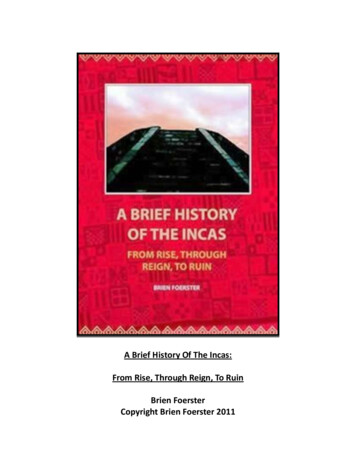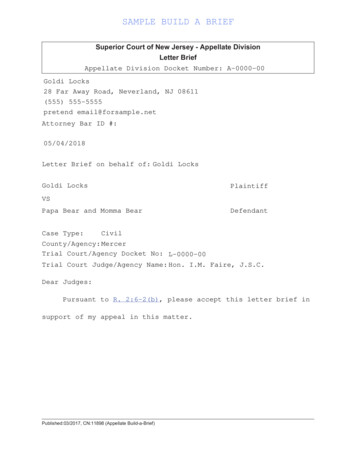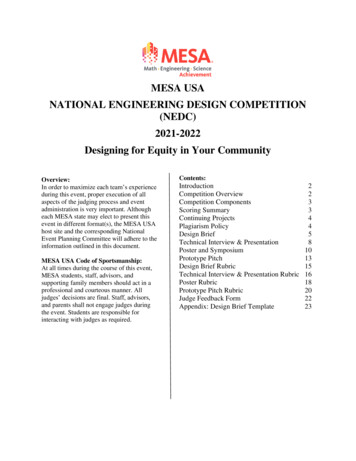
Transcription
A Brief History Of The Incas:From Rise, Through Reign, To RuinBrien FoersterCopyright Brien Foerster 2011
DedicationThis book is lovingly dedicated to Marjorie “Tippy” Fuchs, whoalong with her husband Dick were great supporters of my artisticendeavors for decades. Tippy died during the writing of thisstory, and she was a great supporter and benefactor of Nativepeople and their culture wherever she traveled.I also want to thank my Mother, Ann, for her enduring love andsupport in everything that I have ever done or thought, JimGilbert, my surrogate uncle who fanned the embers of my earlylove of Native art, my father Darryl for his impeccable intellectand “old world” gentry qualities, and my blessed Irene for heramazing natural intelligence, warm heart, and wonderfulinfectious laughter. And finally, to the Inca themselves, whosetrue wisdom and wondrous accomplishments will not onlywithstand the tests of time, but will shine as beacons to futuregenerations of how special humanity is as a creation of thedivine source, the Sun beyond the sun.The main purpose of this book is to give an overview, concise yetthorough, of the origin of the Inca Civilization, its achievementsand splendour, and the reasons why it was overtaken anddestroyed by a relatively small group of Spanish soldiers offortune. The majority of early written accounts of the historyand culture of the Inca have been penned by people of European( mainly Spanish ) origin, and Peruvian Native and/or Mestizo (mixed blood ) who were heavily influenced, one might even saycorrupted and censored, by the Spanish establishment; bothchurch and state. As the old saying goes, ‘ history is written bythe winners.’Since the Inca had no written form of history, most of theinformation in his book has been gleaned from the so-called
winners’ perspective. However, some of the oral traditions havebeen written down, and have been included as much as possible.And as I have accessed many different sources, I feel that bypiecing together this historical puzzle, with hopefully anunbiased approach ( you may differ ) a somewhat balancedaccount may be possible to display. I am neither of Peruvian norSpanish descent, I have no reason to slant this story one way orthe other; I want to know and offer you the truth, as close as Ican come to it.ORIGINSThe most common stories relating to the source of the Incas,where they came from, are that they originally lived around ornear Lake Titicaca, geographically located approximately 150miles south-west of Cuzco. Oral traditions are often very poeticin nature, and many of the traditional Incan accounts say thatManco Capac, and his blood sister Mama Ocllo Huaco, who wereChildren of the Sun God Inti, “rose” from the waters of LakeTiticaca, and were instructed by their celestial father to bringorder back to what had become a chaotic world. These two werenot only brother and sister, but also husband and wife. Mancowas instructed to teach the people the arts of agriculture, andMama Ocllo the arts of weaving and spinning. To say that they“rose” from Lake Titicaca is probably a poetic way of saying thatthey came from that area, their culture rising akin to arenaissance.In terms of archaeological evidence of an advanced civilizationexisting at or near Lake Titicaca before the time of the Inca, oneonly has to visit the massive sacred ceremonial center ofTiahuanaco ( or Tiwanaku ), located approximately 13 miles fromthe eastern shore of Titicaca. In terms of stone architecturaltechnology, it easily rivals, if not surpasses, that of the Incas.
The age of this site is widely and hotly debated; most commonly,however, it is believed that the Tiahunacan culture rose around600 BC, and fell into decline sometime soon after 1000 AD. Amuch more explosive yet compelling theory is that of ArthurPosnansky, a German-Bolivian scholar, who dated the site at15,000 BC. His theory, based on 50 years of study, uses thescience of archaeo-astronomy to compare the alignment of thesolstices present day, as compared to the past.View of the main temple complex of Tiwanaku, with a Viracocha sculpture in the central background.
Sculpture of Viracocha at Tiwanaku, near the famous Gateway Of The Sun.By most accounts, the first Inca arrived in Cusco about 1100 AD,so, in terms of chronological time, Tiahuanaco makes sense asthe site of origin of the Inca. It has also been written by manyauthors that the leaders at Tiahuanaco were priest kings, whowere driven out of their homeland by the Huari, a more war-likeand barbaric people, about 1000 AD. It is also known that thesoil of Tiahuanaco was or had become, by this time, very
infertile, and thus was incapable of growing crops of any greatquality or quantity. This was, in part, due to an extreme El Nino,that caused the area around Tiwanaku to experience a 40 yeardrought.Manco Capac and Mama Ocllo carried with them a golden wedgeor staff called Sunturpaucar, a cage with a sun-bird who couldgive good advice, and other sacred objects. They were instructedby their father Inti to test the land’s fertility as they traveled, forcultivation. Where the golden staff entered the soil easily wasthe place where they should live.A VERY stylized painting of Manco Capac and Mama Ocllo rising from the waters of Lake Titicaca.
When they reached the Sacred Valley, or, more specifically thesite of the present day Coricancha in Cusco, Manco Capacplunged Sunturpaucar into the soil, where it not only entered thesoil easily, but completely disappeared below the surface. Thus,the founding of a new city, and center of a new culture, hadbegun. From a purely practical standpoint, the Sacred Valleywould have been chosen due to its relatively close proximity totheir ancestral lands, and the fact that it has flat, highly arablesoil, nurtured by an major river, the Urubamba, fed by glacialwaters from the Andes.Of course, Manco Capac and Mama Ocllo did not travel alone.Oral traditions speak of their having been 4 pairs of brothers andsisters, all related, who started the journey from Titicacatogether, but the other three pairs, for various reasons, did notcomplete the journey. They were collectively called the Ayarbrothers and sisters. The four sets of brother-sister/wifehusband probably relate to four clans of people.Whether the other three sets of brother-sisters were killed, orbecame subordinate to Manco and Ocllo is uncertain. What isknown is that Manco became the first supreme or Sapa Inca; thefather of the Inca civilization.
The Sacred Valley outside of Cuzco, photographed from the highway winding down to the valley floor.Salkantay, one of the Apus, or guardian mountains near the Sacred Valley.The names and timelines of the Sapa Inca are as follows:Hurin Dynasty:Manco Capac 1200-1230Sinchi Roca1230-1260
LloqueYupanqui 1260-1290Mayta Capac1290-1320Capac Yupanqui 1320-1350Hanan Dynasty:Inca Roca1350-1380Yahuar Huacac 1380-1410Viracocha1410-1438Pachacutec1438 – 1471Tupac Inca Yupanqui 1471 – 1493Huayna Capac1493 – 1527Ninan Cuyochi1527Huascar1527 – 1532Atahualpa1532 – 1533
This painting, like all those in post-Inca times, is speculative ofthe facial features of the Sapa Inca.Three major tribes lived in the Cusco valley area when MancoCapac and Mama Ocllo arrived. They were the Sawasiray, theAllkawisas and the Maras, who had formed an alliance that theInca joined. The political power of this confederated state wasdivided between two groups: the Hanan, which controlled mostof the political and religious power, and the Hurin, which was incharge of the military. At this time, the Inca were put in charge ofthe Hurin aspect of the confederation, but maintained theiradherance to their God Inti.During the 14th century, the leaders Sinchi Roca, Lloki Yupanqui,Mayta Capa, and Capac Yupanqui led several wars againstneighbouring tribes of Cusco. By the time that Capac Yupanqui
died, Inca Roca had gained enough power to become Hanan, andthus controlled all aspects of political, religious, and militaryaffairs. After Inca Roca’s death, the Inca state began to declineunder the rule of Yahuar Huacac. However, the next Sapa Inca,Viracocha, stabilized the state, which now reached a 50 kmradius from Cusco. At this time the Chanka tribe had expandedits territories south of Cusco, and along with an alliance of othersouthern tribes, made a move to attack Cusco.The Chanka army greatly outnumbered that of the Inca, and asthe battle started, the Chanka placed a statue of their founder infront of their troops. During the battle, the Inca took control ofthe statue, and perhaps seeing this as a terrible omen, theChanka deserted the battlefield. The next Sapa Inca, Pachacutec,whose name roughly translates as “ earth shaker “ began thegreat expansion period of the confederation. During his reign, heand his son, Tupac Inca Yupanqui brought much of the Andesmountains, under Inca control.
Stylized painting of the Sapa Inca Pachacutec.Pachacutec was the founder of the Tahuantinsuyu; a federalistsystem which consisted of a central government with the SapaInca at its head, in Cusco, and four provincial governments withstrong leaders: Chinchsuyu (NW), Antisuyu (NE), Contisuyu ( SW),and Collasuyu (SE.) Pachacuti is also regarded as the builder ofMachu Picchu. What sets the Inca’s method of territorial
expansion at this time, and perhaps earlier, from other culturesis both intriguing and very clever. They formed a confederation,not an empire, and this point can not be emphasized enough.Empires tend to grow based on the subjugation and destructionof other groups and nations; not only their political systems andmilitary, but also their belief systems. A confederation is analliance of groups and or nations under a central guiding andcoordinating authority.Pachacutec sent spies to regions that he wanted to expand into.These spies brought back reports on the political organization,military might, and wealth of the prospective confederationcandidates. He would then send messages to the leaders of theselands extolling the benefits of joining the confederation, offeringthem presents of luxury goods such as high quality textiles.Benefits to the candidate lands included access to the extensiveInca road system, some 15000 to 25000 miles in size, and thegoods and services that were within the realm of the Inca’ssphere of influence. The benefits to the Inca were access togoods and services that were particular to that region.Most accepted the rule of the Inca, and acquiesced peacefully. Itwas only when a perspective Candidate refused to join theconfederation that military force was used.It was traditional for the Inca’s first born son to lead the army,and from the time of Manco Capac to Huayna Capac the firstborn son inherited the title of Sapa Inca. Pachacutec’s son TupacInca began conquests to the north in 1463, and continued themas Inca after Pachacutec’s death in 1471. His most important“conquest “ was the kingdom of Chimor ( Chan chan is a remnantof that culture ) the Inca’s only serious rival on the north coast ofPeru. Tupac Inca then expanded into modern day Ecuador andColombia.
The age of this site is widely and hotly debated; most commonly, however, it is believed that the Tiahunacan culture rose around 600 BC, and fell into decline sometime soon after 1000 AD.











